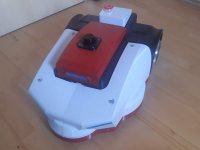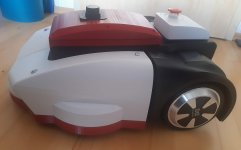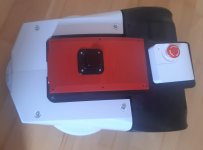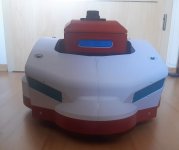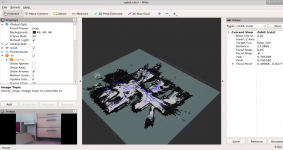Hartmut
Active member
Ich habe diese Treiber am 1.3 Board. Geht aber genauso mit dem 1.4. Board.
Mit der Adapterplatine V1.1 06/21 unverändert.
GND an GND
VR an Motor xxx PWM
Z/F an Motor xxx Dir
Signal an Motor xxx AVI (Hall)
EL an Motor Enable
5V nicht verbunden
Alles andere an K5 nicht verbunden.
Dann in der AmRobotDriver.cpp je nach Motor noch zwei Zeilen anpassen.
void AmMotorDriver::setBrushless(int pinDir, int pinPWM, int speed) {
//DEBUGLN(speed);
if (speed < 0) {
digitalWrite(pinDir, HIGH) ;
//if (speed >= -2) speed = -2;
pinMan.analogWrite(pinPWM, ((byte)abs(speed)));
} else {
digitalWrite(pinDir, LOW) ;
// if (speed <= 2) speed = 2;
pinMan.analogWrite(pinPWM, ((byte)abs(speed)));
}
}
Drehen die Motoren nicht an, dann die Zeilen auskommentieren. Drehen die Motoren im Stillstand dann Wert um 1 erhöhen.
Achtung:
Batterie an P+ und P-
Vor Anschluss an das 1.3 oder 1.4 Board sollten die Motoren mit einem 10k Poti an GND und 5 Volt und der Abgriff auf VR einwandfrei laufen und auch bei GND an ZF die Richtung umschalten.
Mit der Adapterplatine V1.1 06/21 unverändert.
GND an GND
VR an Motor xxx PWM
Z/F an Motor xxx Dir
Signal an Motor xxx AVI (Hall)
EL an Motor Enable
5V nicht verbunden
Alles andere an K5 nicht verbunden.
Dann in der AmRobotDriver.cpp je nach Motor noch zwei Zeilen anpassen.
void AmMotorDriver::setBrushless(int pinDir, int pinPWM, int speed) {
//DEBUGLN(speed);
if (speed < 0) {
digitalWrite(pinDir, HIGH) ;
//if (speed >= -2) speed = -2;
pinMan.analogWrite(pinPWM, ((byte)abs(speed)));
} else {
digitalWrite(pinDir, LOW) ;
// if (speed <= 2) speed = 2;
pinMan.analogWrite(pinPWM, ((byte)abs(speed)));
}
}
Drehen die Motoren nicht an, dann die Zeilen auskommentieren. Drehen die Motoren im Stillstand dann Wert um 1 erhöhen.
Achtung:
Batterie an P+ und P-
Vor Anschluss an das 1.3 oder 1.4 Board sollten die Motoren mit einem 10k Poti an GND und 5 Volt und der Abgriff auf VR einwandfrei laufen und auch bei GND an ZF die Richtung umschalten.
Anhänge
Zuletzt bearbeitet:
